Gallery of Weather and Climate
Disclaimer: This material is being kept online for historical purposes. Though accurate at the time of publication, it is no longer being updated. The page may contain broken links or outdated information, and parts may not function in current web browsers.
Gallery of Weather and Climate
-
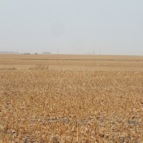 Leaving crop residue on the land can protect the topsoil from damaging winds.
Photo credit: USDA.
Leaving crop residue on the land can protect the topsoil from damaging winds.
Photo credit: USDA.
-
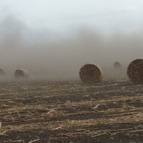 Wind rips through the Northern Plains, removing precious topsoil.
Photo credit: USDA.
Wind rips through the Northern Plains, removing precious topsoil.
Photo credit: USDA.
-
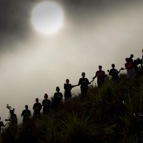 Workers in Haiti build a rock wall to save arable land from erosion.
Photo credit: UN Photo/Logan Abassi.
Workers in Haiti build a rock wall to save arable land from erosion.
Photo credit: UN Photo/Logan Abassi.
-
 Wind and dry soil combine to cause serious erosion. Photo credit: Natural England/Peter Roworth.
Wind and dry soil combine to cause serious erosion. Photo credit: Natural England/Peter Roworth.
-
 A eucalyptus tree is planted in an effort to prevent the spread of the desert in Senegal.
Photo credit: UN Photo.
A eucalyptus tree is planted in an effort to prevent the spread of the desert in Senegal.
Photo credit: UN Photo.
-
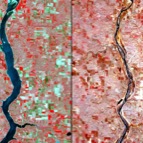 The Missouri River during normal conditions (left) and in severe drought (right).
Photo credit: NASA/GSFC/METI/Japan Space Systems and the U.S./Japan ASTER Science Team.
The Missouri River during normal conditions (left) and in severe drought (right).
Photo credit: NASA/GSFC/METI/Japan Space Systems and the U.S./Japan ASTER Science Team.
-
 The Cheyenne Bottoms Wildlife Wetlands in Kansas, shown from 2010 (left) to 2012 (right), has suffered from severe drought.
Photo credit: U.S. Department of the Interior / USGS and NASA.
The Cheyenne Bottoms Wildlife Wetlands in Kansas, shown from 2010 (left) to 2012 (right), has suffered from severe drought.
Photo credit: U.S. Department of the Interior / USGS and NASA.
-
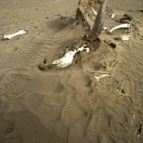 A partially buried skeleton in the drought-affected region of St Louis, Senegal.
Photo credit: UN Photo/John Isaac.
A partially buried skeleton in the drought-affected region of St Louis, Senegal.
Photo credit: UN Photo/John Isaac.
-
 This cracked earth in Senegal is created by a lack of water and intense heat.
Photo credit: UN Photo/Evan Schneider.
This cracked earth in Senegal is created by a lack of water and intense heat.
Photo credit: UN Photo/Evan Schneider.
-
 The Muir Glacier in Alaska in 1941 (left) and 2004 (right). Global warming has caused many glaciers to shrink.
1941 photo taken by Ulysses William O. Field; 2004 photo taken by Bruce F. Molnia. Courtesy of the Glacier Photograph Collection, National Snow and Ice Data Center/World Data Center for Glaciology.
The Muir Glacier in Alaska in 1941 (left) and 2004 (right). Global warming has caused many glaciers to shrink.
1941 photo taken by Ulysses William O. Field; 2004 photo taken by Bruce F. Molnia. Courtesy of the Glacier Photograph Collection, National Snow and Ice Data Center/World Data Center for Glaciology.
-
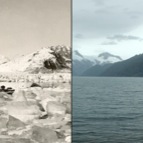 A glacier in Alaska in 1940 (left) and 2005 (right). Global warming has caused much of this glacier to melt.
1940 photo taken by unknown photographer; 2005 photo taken by Bruce F. Molnia. Courtesy of the Glacier Photograph Collection, National Snow and Ice Data Center/World Data Center for Glaciology.
A glacier in Alaska in 1940 (left) and 2005 (right). Global warming has caused much of this glacier to melt.
1940 photo taken by unknown photographer; 2005 photo taken by Bruce F. Molnia. Courtesy of the Glacier Photograph Collection, National Snow and Ice Data Center/World Data Center for Glaciology.
-
 A glacier in Switzerland. Global warming has caused many glaciers to shrink.
Photo credit: Skittledog.
A glacier in Switzerland. Global warming has caused many glaciers to shrink.
Photo credit: Skittledog.
-
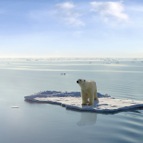 A polar bear floats on a small piece of arctic ice. Their habitat is constantly shrinking due to global warming.
Photograph by Gerard Van der Leun.
A polar bear floats on a small piece of arctic ice. Their habitat is constantly shrinking due to global warming.
Photograph by Gerard Van der Leun.
-
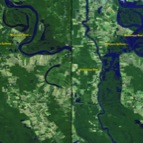 Flooding of the Mississippi river in Louisiana. Climate change may cause more intense weather around the world. Photo credit: U.S. Department of the Interior / U.S. Geological Survey.
Flooding of the Mississippi river in Louisiana. Climate change may cause more intense weather around the world. Photo credit: U.S. Department of the Interior / U.S. Geological Survey.
-
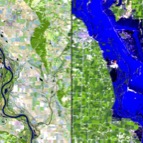 Flooding of the Mississippi river (right) in Iowa compared to normal water levels (left). Climate change may create more intense weather.
Photo credit: U.S. Department of the Interior / U.S. Geological Survey.
Flooding of the Mississippi river (right) in Iowa compared to normal water levels (left). Climate change may create more intense weather.
Photo credit: U.S. Department of the Interior / U.S. Geological Survey.
-
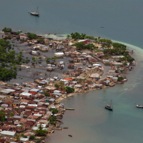 Flooding and damage caused by Hurricane Sandy in Haiti. Global warming may increase the intensity of storms like Hurricane Sandy.
Photo credit: UN Photo/Logan Abassi.
Flooding and damage caused by Hurricane Sandy in Haiti. Global warming may increase the intensity of storms like Hurricane Sandy.
Photo credit: UN Photo/Logan Abassi.
-
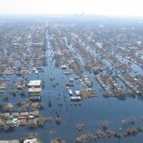 Flooding in the aftermath of Hurricane Katrina. Global warming may increase the intensity of storms like Hurricane Katrina.
Flooding in the aftermath of Hurricane Katrina. Global warming may increase the intensity of storms like Hurricane Katrina.
-
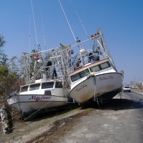 Aftermath of flooding from Hurricane Katrina. Global warming may increase the intensity of storms like Hurricane Katrina.
Aftermath of flooding from Hurricane Katrina. Global warming may increase the intensity of storms like Hurricane Katrina.












